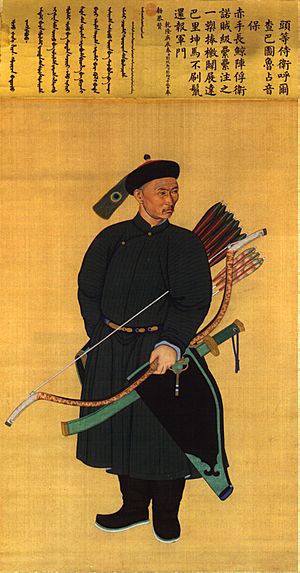Northern Shaolin (martial art) facts for kids

Northern Shaolin (also called Běi Shàolín in Pinyin or Pek Sil Lum in Cantonese) is a famous style of Chinese martial arts. It comes from the Northern Shaolin Monastery in Henan, China. This style is known for its powerful and graceful movements.
Contents
What Makes Northern Kung Fu Special?
Northern styles of martial arts, also known as Běi pài (北派), use big, wide stances. These include the horse, bow, drop, and dragon stances. Fighters move smoothly and quickly from one stance to another. This helps them change direction fast when they use their power.
Many well-known martial arts styles are part of the Northern group. Some examples are Baguazhang, Bajiquan, Chāquán, Chuojiao, Eagle Claw, Northern Praying Mantis, and Taijiquan. The style called Chángquán is often seen as the main Northern style. It's even a separate part of modern Wushu training.
Northern martial arts look very different from the styles practiced in Southern China. Generally, Northern styles focus more on using your legs, kicking, and doing acrobatic moves. You can even see the influence of Northern styles in traditional Korean martial arts, which also use a lot of high kicks.
Some people think that the high kicks and flying kicks you see in Southern styles, and even in Okinawan martial arts like karate and taekwondo, came from Northern styles. This influence might have spread in the early 1900s.
Key Features of Northern Shaolin
The Northern Shaolin style of kung fu is one of the most important traditional northern styles of Chinese martial arts. These Northern styles usually focus on fighting from a distance. They use quick moves to advance and retreat. They also use wide stances, lots of kicks, and jumping techniques. You'll see spinning blocks, quickness, agility, and strong attacks.
This style teaches both empty-hand techniques and how to use weapons. Students learn these through special practice routines called forms or sets. First, students practice these routines until the movements feel natural. Then, they practice with a partner or a group. This helps them learn how to use the techniques in real situations. These practice routines are not just useful; they are also beautiful and artistic. The smooth movements and acrobatic techniques are a special part of Northern Shaolin sets.
Gu Ru Zhang: A Northern Shaolin Master
The Northern Shaolin style became very famous thanks to a master named Gu Yu-jeung. Many stories are told about Gu's amazing skills. His students said that Gu's father was also a great fighter, known for the Tan Tui ("springing leg") form.
When Gu was young, he traveled all over Northern China. He wanted to learn all the different northern kung fu systems. He was especially famous for his Iron Palm techniques, which meant he could hit incredibly hard. He was also skilled with a long spear. Gu took everything he learned and organized it into what we now know as the Northern Shaolin style.
Northern Shaolin Forms by Gu Ru Zhang
Gu Ru Zhang organized the Northern Shaolin style into ten main forms or routines. Each form has a special name and meaning. These forms help students learn different techniques and movements.
| English Name | Chinese | Mandarin Pinyin | Cantonese | Meaning |
|---|---|---|---|---|
| Open the Door | 開門 | Kāi Mén | Hoi Moon | open the door |
| Lead the Way | 領路 | Lǐng Lù | Ling Lo | lead the way |
| The Sitting Horse | 坐馬 | Zuò Mǎ | Choh Ma | sit on the horse |
| Pierce the Heart | 穿心 | Chuān Xīn | Cheun Sam | penetrate the heart |
| Martial Skill | 武藝 | Wǔ Yì | Mo Ngai | martial skill |
| Short Strike | 短打 | Duǎn Dǎ | Duen Da | hand to hand combat |
| Plum Flower | 梅花 | Méi Huā | Mui fa | plum flower |
| Uprooting Step | 拔步 | Bá Bù | Boot Bo | pluck the stance |
| Chained Fist | 連環拳 | Liánhuánquán | Lin Wan Kuen | Continuous Fist |
| Pattern Method | 式法 | Shì Fǎ | Sik Faat | knowing the way |

